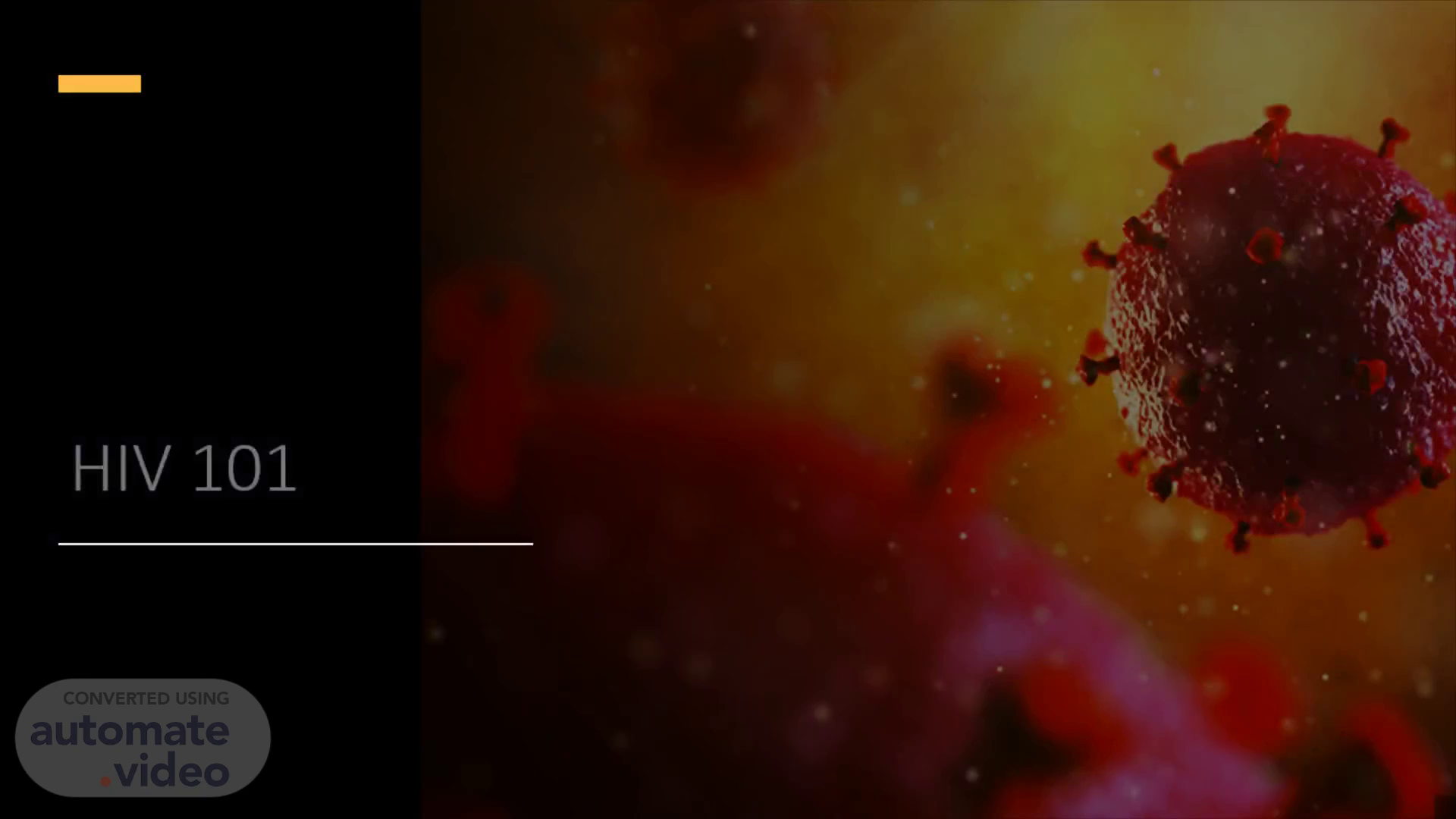Scene 1 (0s)
A picture containing dish, blurry, close Description automatically generated.
Scene 2 (8s)
Outline. What is HIV? What is AIDS? How is HIV and AIDS transmitted HIV is not transmitted Symptoms of HIV Treatment Risk Reduction U=U PrEP PEP.
Scene 3 (20s)
What is HIV?. HIV (Human Immunodeficiency Virus) is a virus that attacks the body’s immune system. If HIV is not treated, it can lead to AIDS . There is currently no effective cure. Once people get HIV, they have it for life. With proper medical care, HIV can be controlled. People with HIV can live long, healthy lives , become undetectable, and untransmissible..
Scene 4 (40s)
What is AIDS?. AIDS ( Acquired Immunodeficiency Syndrome ) is the most severe phase of HIV infection, categorized by the CD4 cell count dropping below 200 cells/mm, or after the development of certain opportunistic infections. Opportunistic infections are illnesses that happen more frequently in those with compromised or damaged immune systems. Once the body has regressed to this stage, the diagnosis will remain, but with proper care and precautions, people can continue to live healthy lives..
Scene 5 (1m 3s)
How is HIV transmitted?. HIV transmission —transmitted through the following body fluids: blood (including menstrual blood) semen ( cum ) pre-seminal fluid ( pre-cum ) vaginal fluids breast milk.
Scene 6 (1m 21s)
How HIV is not Transmitted. HIV does not survive long outside the human body (such as on surfaces), and it cannot reproduce outside a human host. It is not transmitted: By mosquitoes, ticks, or other insects Through saliva, tears, or sweat By hugging, shaking hands, sharing toilets, sharing dishes, or closed-mouth or “social” kissing with someone who has HIV Through other sexual activities that don’t involve the exchange of body fluids (for example, touching) Through the air.
Scene 7 (1m 44s)
Symptoms. Main jmptoms of Acute HIV infection -Weight loss Pharyngitis Mouth: - Sores Esophagus: • Sores Muscles: . Myalgia Liver and spleen • Enlargement Central: • Malaise • Headache • Neuropathy Lymph nodes: • Lymphadenopathy Skin: Gastric: •Nausea •Vomiting.
Scene 8 (2m 0s)
Stages of HIV. Infection – HIV enters the bloodstream and take up residence in the cells. Mild flu like symptoms More severe reactions Primary (or Acute) HIV infection - HIV actively replicates (about 2 months) producing a very high viral load. Takes up to 3 months to develop antibodies Asymptomatic Stage (or clinical latency)- person appears healthy but immune system is weakened..
Scene 9 (2m 18s)
Undetectable = Untransmittable. Not that long ago, AIDS was a major concern for the queer community. These days, treatment options exist and stigma reduction is incredibly important in winning the battle against HIV. So What Is U = U? A scientifically backed campaign that essentially states if someone who is HIV+ is taking their antiretroviral medication, and have been consistently for 6 months or longer, the level of HIV virus in their body will be so low that there is virtually no risk of transmitting the HIV to a partner. This means someone living with HIV is virally suppressed, and can go on living a normal life..
Scene 10 (2m 45s)
Risk Reduction: Condoms. Internal Condoms. Meant to be used internally: for either vaginal or anal sex Give the receptive partner more control over their sexual autonomy Not made of latex Can be inserted up to 8 hours before sexual activity.
Scene 11 (3m 5s)
Who's at Risk?. HIV can affect anyone regardless of sexual orientation, race, ethnicity, gender or age. However, certain groups are at higher risk for HIV reason being because of particular risk factors. Those especially at risk: Men who have Sex with Men (MSM) African American/Black individuals Latinx individuals People Who Inject Drugs (PWID) Why is this the case?.
Scene 12 (3m 34s)
A picture containing chart. Timeline Description automatically generated.
Scene 13 (3m 42s)
Risk Reduction: Dental Dams. Used for oral sex, dams create a barrier between the mouth and genitals/anus. Typically a square piece of latex or polyurethane. Some tips: Like condoms, dams are one time use In a pinch, a dam can be made out of a condom You can also use non microwaveable plastic wrap Dams can be used on a penis, but flavored condoms should be used instead as they offer more protection (Side Note: anything with flavor has sugar – sugar only goes in the mouth!).
Scene 14 (4m 5s)
Risk Reduction: Lube. Lubrication is very important to prevent discomfort, as well as (micro)tears, especially for non-lubricating spots like the anus or penis. Types of Lube: Water based : non-staining; easy to clean; compatible with condoms/sex toys; may need to reapply; good for people with sensitive skin Silicone Based : long lasting; doesn’t wash away easily; cannot be used with silicone-based toys; safe for condom usage; may stain Oil Based : ideal for unprotected sex/masturbation; not safe for condoms (as they may break); also not safe for use with latex sex toys; can be difficult to clean.
Scene 15 (4m 33s)
What is PrEP?. Pre-Exposure Prophylaxis Oral PrEP – once a day pill that helps prevent HIV by reducing the risk of becoming infected if a person comes in contact with HIV. Up to 99% effective at reducing the risk of HIV. Truvada Descovy Injectable PrEP – newly-approved method involving injections every two months.
Scene 16 (4m 54s)
PrEP: Pre-Exposure Prophylaxis. People who use PrEP must commit to taking the drug every day and seeing their health care provider every 3 months for follow-up..
Scene 17 (5m 9s)
PEP: Post Exposure Prophylaxis. PEP involves taking anti-HIV drugs as soon as possible - after a potential exposure to prevent HIV infection.
Scene 18 (5m 22s)
Works Cited. HIV and AIDS Resources | HIV.gov https://www.cdc.gov/hiv/default.html https://www.cdc.gov/hiv/basics/statistics.html HIV: It’s Called Treatment as Prevention – YouTube Gilead HIV: The Goal of Undetectable - YouTube.
